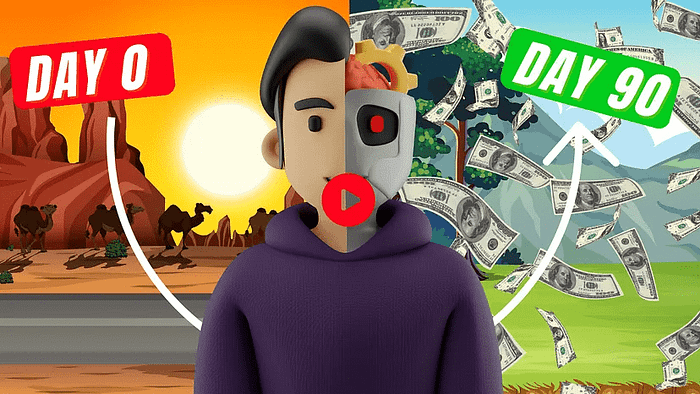How AI Blog Writing Tools Craft Irresistible Posts
AI blog writing has revolutionized the way we create content online. If you’ve been struggling to produce high-quality blog posts, you’re in for a treat.
I’m about to walk you through the entire process of crafting a killer blog post with the help of artificial intelligence. We’ll explore everything from finding the perfect keywords to repurposing your content for maximum impact.
The most crucial aspect of this guide is learning how to match keywords with search intent. You’ll discover how to approach SEO strategically while keeping social media in mind. I’ll show you how to use AI to create a blog post outline that aligns with search intent and explain why your introduction can make or break your article.
Throughout this journey, we’ll delve into the world of AI-assisted writing, but we won’t forget the human touch that makes content truly resonate with readers.
TL;DR: Learn how to leverage AI blog writing tools to create compelling, SEO-optimized content that engages your audience and boosts your online presence.
We strongly recommend that you check out our guide on how to take advantage of AI in today’s passive income economy.
Table of Contents
Finding Keywords That Match Search Intent
Understanding what your audience is searching for is the cornerstone of effective AI blog writing. Search intent, also known as user intent, is the primary goal a user has when typing a query into search engines.
For instance, if someone wants to brew coffee at home, they might search for “how to make coffee at home.” The search results should populate with information or blog posts that address this specific query.
Instead of manually brainstorming keywords, you can use free and paid tools to identify high-intent keywords. This approach allows you to create content that precisely matches what your audience is looking for.
One free tool you can use is Ahrefs’ Keyword Generator. By navigating to their footer, you’ll find a treasure trove of SEO tools at your disposal.
Let’s say you want to write about coffee. You could enter “best coffee” into the Keyword Generator. The tool will provide you with a list of related keywords, such as:
- Best coffee grinder
- Best coffee machine
- Best coffee maker with grinder
- Best coffee creamers
You’ll also find question-based keywords like “how to make the best coffee.” These questions are goldmines for creating informative content that directly addresses user queries.
When using AI blog writing techniques, it’s essential to focus on long-tail keywords or trending topics. Put yourself in your customer’s shoes. If you’re selling a digital product, offering affiliate marketing deals, or providing services, what questions might your audience be asking?
By creating content around these questions, you’re not just writing; you’re providing valuable answers that match user intent. This approach is crucial because without it, your beautifully crafted post might never be found.
The key types of search intent to focus on are:
- Informational posts: How-to guides, case studies, and long-form list content.
- Transactional posts: “Best of” product roundups, where you can generate affiliate revenue.
- Commercial content: Product reviews, comparison posts, and alternatives to different tools and services.
These three types of content should form the backbone of your content strategy when using AI blog writing tools.
SEO-Driven Approach with Social Content in Mind
Now that we’ve nailed down our keywords and search intent, it’s time to optimize our content for search engines while keeping social sharing in mind. This dual approach ensures that your AI blog writing efforts yield maximum results.
First, consider using an on-page SEO tool like Surfer SEO, Phrase, or a budget-friendly alternative. These tools provide valuable insights into:
- Semantic keywords to include in your content
- Optimal word count
- Number of images to use
- Heading structures that perform well
While not everyone needs these tools, they can be incredibly helpful if you’re in a competitive niche like B2B SaaS or marketing.
When crafting your content, think about how it will be shared on social media. Ask yourself:
- What would make this content visually appealing?
- How can I incorporate emotional elements?
- What copywriting techniques can I use to hook readers?
- Would a video enhance the user experience?
As a reader, you want guidance, entertainment, and value from an article. As a content creator using AI blog writing tools, it’s your job to provide that experience.
Don’t forget about mobile-friendliness. With more people accessing content on their smartphones, ensuring your layout works well on smaller screens is crucial.
Another often-overlooked aspect of content creation is color scheme. Using a tool like Coolors can help you generate a pleasing color palette for your blog. This attention to detail can significantly enhance the user experience and make your content more shareable.
Creating a Blog Post Outline with AI
An well-structured outline is the backbone of any great blog post. When it comes to AI blog writing, you have two main options for creating your outline:
- Use an AI-powered outline builder within tools like Surfer SEO
- Craft a custom prompt for ChatGPT or similar AI language models
Let’s explore both methods:
Using Surfer SEO’s AI Outline Builder:
- Enter your main keyword into Surfer SEO’s Content Editor.
- Adjust settings for your target location and device (mobile/desktop).
- Click “Create” to generate a content editor credit.
- Once the analysis is complete, click on the “Outline” feature.
- Review the AI-generated outline, which includes competitor-inspired headings.
Using a Custom AI Prompt:
You can use the following prompt with ChatGPT or your preferred AI tool:
“Create a blog post outline that matches the [INTENT] intent without including irrelevant sections. The blog post title is ‘[TITLE]’.”
For example:
“Create a blog post outline that matches the informational intent without including irrelevant sections. The blog post title is ‘How to Write Content for Local SEO’.”
The AI will generate an outline that you can then refine and customize.
Regardless of which method you choose, remember that AI blog writing tools are meant to assist, not replace your judgment. Always review and adjust the outline to ensure it aligns with your vision and expertise.
Crafting a Compelling Introduction
The introduction is arguably the most critical part of your blog post. It’s your chance to grab the reader’s attention and convince them to keep reading. When it comes to AI blog writing, crafting a compelling introduction requires a delicate balance between human creativity and AI assistance.
Here’s how to write an introduction that hooks your readers:
- Use a copywriting framework like AIDA (Attention, Interest, Desire, Action) or PAS (Problem, Agitation, Solution).
- Clearly state the value the reader will get from your article.
- Adopt a conversational tone that feels relatable while still adhering to SEO best practices.
- Keep it concise and compelling – no fluff allowed!
- Always fact-check and personalize your content, even when using AI assistance.
Here’s an example of how you might use AI to help craft your introduction:
Prompt: “Write a blog post introduction that uses the AIDA framework to hook my readers. Keep it conversational with zero fluff and jargon. Include a summary box or TL;DR at the end of the introduction. Use roughly 120 words and incorporate these exact keywords: [KEYWORD1], [KEYWORD2], [KEYWORD3].”
By providing specific instructions, you ensure that the AI-generated content aligns with your goals and style.
Remember, the introduction sets the tone for your entire article. It’s worth spending extra time to get it right, even if you’re using AI blog writing tools to speed up the process.
Writing the Main Content
With your outline and introduction in place, it’s time to dive into the meat of your article. AI blog writing can significantly speed up this process, but it’s essential to maintain your unique voice and expertise.
Here are some tips for writing your main content:
- Focus on clarity: Make complex information easily digestible.
- Use AI to assist, not replace: Write sections yourself and use AI for editing or expansion.
- Break up content with subheadings: This improves readability and helps with SEO.
- Use line breaks liberally: White space makes your content easier to read.
- Fact-check rigorously: AI can make mistakes, so always verify information.
- Personalize your content: Add your own experiences and insights.
When using AI for content generation, work on one section at a time. This approach helps prevent the AI from going off-topic or producing irrelevant information.
Here’s an example of how you might use AI to help write a section:
Prompt: “Write the next section using an 8th-grade reading level. The H2 is ‘[HEADING]’. Use these exact keywords: [KEYWORD1], [KEYWORD2], [KEYWORD3]. Use approximately 100 words.”
By providing specific instructions, you can ensure that the AI-generated content fits seamlessly into your article while maintaining readability and incorporating important keywords.
Remember, AI blog writing tools are meant to enhance your writing process, not replace your expertise. Always review and refine the AI-generated content to ensure it aligns with your voice and message.
Adding Visual Elements for Higher Retention
In the world of AI blog writing, it’s easy to focus solely on text. However, visual elements play a crucial role in keeping readers engaged and improving retention rates. Whether you’re optimizing for Google SEO or creating social media-first content, visuals can significantly impact your content’s performance.
Here’s why visual elements are essential:
- They break up text, making your content more digestible.
- They increase the time visitors spend on your page.
- They help explain complex concepts more effectively than text alone.
- They make your content more shareable on social media platforms.
Types of visual elements to consider:
- Images: Custom graphics, stock photos, or infographics
- Videos: Explainer videos, tutorials, or interviews
- Charts and graphs: To visualize data and statistics
- Interactive elements: Quizzes, polls, or calculators
When adding visuals to your AI blog writing, keep these tips in mind:
- Ensure all visuals are relevant to your content.
- Optimize images for quick loading times (use compression tools).
- Include alt text for accessibility and SEO benefits.
- Create custom graphics using tools like Canva for a unique look.
Here’s how you might use Canva to create a custom blog post image:
- Open Canva and select a blog post template.
- Choose a background image or color that matches your brand.
- Add your blog post title using an eye-catching font.
- Incorporate relevant icons or illustrations.
- Include your logo or website URL for branding.
- Export the image in the appropriate format and size for your blog.
Remember, while AI blog writing can speed up your content creation process, visual elements often require a human touch. Take the time to create or select visuals that truly enhance your content and resonate with your audience.
Repurposing Content for Maximum Reach
Once you’ve created a killer blog post using AI blog writing techniques, don’t let it sit idle. Repurposing your content allows you to maximize its reach and impact across various platforms.
Here are some ways to repurpose your blog content:
- Social media posts: Turn key points into bite-sized posts for platforms like Twitter, LinkedIn, or Instagram.
- Video scripts: Use your blog post as a basis for YouTube videos or TikTok content.
- Email sequences: Break down your post into a series of emails for your subscribers.
- Lead magnets: Expand on your blog post to create downloadable guides or eBooks.
- Podcast episodes: Use your blog post as a script for an audio version of your content.
When repurposing content, keep these tips in mind:
- Tailor the content to each platform’s unique characteristics and audience expectations.
- Add new insights or examples to keep the repurposed content fresh.
- Use AI tools to help with the repurposing process, but always add your personal touch.
- Ensure consistency in messaging across all platforms.
Here’s an example of how you might use AI to help repurpose your content:
Prompt: “Write a LinkedIn thread that could go viral based on my blog post about [TOPIC]. Use line breaks and a powerful, short hook in the first sentence. Use an 8th-grade reading level.”
The AI will generate a draft that you can then refine and personalize for your LinkedIn audience.
Remember, while AI blog writing tools can help with the initial content creation and repurposing, it’s crucial to inject your unique voice and expertise into each piece of content you publish.
Conclusion
Mastering the art of AI blog writing can transform your content creation process, helping you produce high-quality, engaging posts more efficiently than ever before. From finding the right keywords to repurposing your content for maximum reach, AI tools can assist at every stage of the blogging journey.
However, it’s crucial to remember that AI is a tool, not a replacement for human creativity and expertise. The most successful bloggers use AI to enhance their writing process, not to automate it entirely.
As you implement these AI blog writing techniques, always keep your audience in mind. Strive to create content that not only ranks well in search engines but also provides genuine value to your readers. With practice and persistence, you’ll soon be crafting killer blog posts that engage, inform, and inspire your audience.
Remember, the world of AI and content creation is constantly evolving. Stay curious, keep learning, and don’t be afraid to experiment with new tools and techniques. Your next killer blog post might be just an AI prompt away!
Frequently Asked Questions:
Is it OK to use AI to write blog posts?
Using AI for blog writing can be an effective tool when used responsibly. AI blog writing can help streamline your content creation process, generate ideas, and even assist with research. However, it’s important to remember that AI should be used as a supplement to your own expertise and creativity, not a replacement.
The key is to use AI as a starting point or a collaborative tool. Always review, edit, and personalize AI-generated content to ensure it aligns with your brand voice, provides accurate information, and offers unique insights that your audience values.
Ultimately, the goal is to create high-quality, engaging content that serves your readers’ needs. If AI helps you achieve this goal more efficiently, then it can be a valuable addition to your content creation toolkit.
What are the limitations of AI writing?
While AI blog writing tools have come a long way, they still have several limitations:
- Lack of real-world experience: AI can’t draw from personal experiences or provide original insights based on lived experiences.
- Limited context understanding: AI may miss nuances or cultural references that a human writer would easily grasp.
- Potential for inaccuracies: AI can sometimes generate false or outdated information, which is why fact-checking is crucial.
- Inability to form original opinions: AI can summarize existing information but can’t form truly original thoughts or arguments.
- Lack of emotional intelligence: AI may struggle to capture the right tone or emotional nuance for sensitive topics.
- Ethical considerations: AI can’t make ethical judgments about content appropriateness or potential impact.
- Creativity limitations: While AI can be creative within certain parameters, it may struggle with highly original or “out-of-the-box” thinking.
Remember, these limitations highlight why human oversight and input remain essential in the content creation process.
How to write a blog through AI?
Writing a blog post using AI involves several steps:
- Choose your topic and main keywords.
- Use an AI tool like ChatGPT, Jasper, or Copy.ai to generate an outline.
- Prompt the AI to write sections of your post, including the introduction, main points, and conclusion.
- Review and edit the AI-generated content, adding your own insights and experiences.
- Use AI to help with SEO optimization by suggesting related keywords and phrases.
- Prompt the AI to generate meta descriptions and social media posts to promote your blog.
- Always fact-check the information provided by the AI and ensure the content aligns with your brand voice.
- Add your own examples, case studies, or personal anecdotes to make the content unique.
- Use AI to help with proofreading and suggesting improvements in readability.
Remember, the key to successful AI blog writing is to use it as a tool to enhance your own writing, not to replace your unique perspective and expertise entirely.
Can Google detect AI written blogs?
As of 2024, Google has stated that it doesn’t have a specific system to detect AI-generated content. Their focus is on the quality, relevance, and usefulness of the content, regardless of how it was produced.
However, Google’s algorithms are sophisticated and continually evolving. They can potentially identify patterns or characteristics common in AI-generated text, such as:
- Lack of depth or original insights
- Overuse of certain phrases or sentence structures
- Inconsistencies in tone or style
- Absence of personal anecdotes or real-world examples
To ensure your AI blog writing doesn’t raise red flags:
- Heavily edit and personalize AI-generated content
- Add unique insights, examples, and data points
- Ensure the content provides genuine value to readers
- Maintain a consistent brand voice across all your content
- Include multimedia elements like images, videos, or infographics
Remember, Google’s primary goal is to provide users with high-quality, relevant content. If your AI-assisted blog posts meet these criteria, they should perform well regardless of how they were initially drafted.

We strongly recommend that you check out our guide on how to take advantage of AI in today’s passive income economy.




